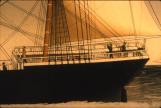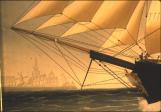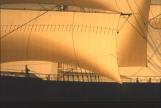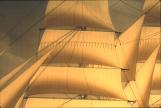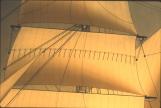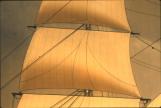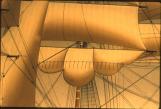27
Slide 6.13In this illustration one of the ship's boats can be seen - turned upside down and lashed to the boat skids. Ships usually carried two or three boats which could be used to transfer people and goods between the ship and other vessels or the shore. They were also used for lifesaving either for rescuing crews from other ships or themselves if their own vessel had to be abandoned.
The white bands around the mast indicate that this mast was a 'built mast' - made up of several pieces of wood bound together rather than one stick of wood.
The 'ratlines' which the sailors climbed to handle the upper sails can also be clearly seen in this part of the painting.
29
Slide 6.14The 'poopdeck' is the remaining evidence of the old medieval ship's 'after castle' (see illustration 6.10). The ship was controlled from this area, both literally and figuratively. The ship's wheel was situated near the 'stern' (and above the 'rudder') and controlled the direction in which the ship was headed. The captain or his officer in charge remained on the poopdeck to direct the operations of the crew. The three figures in this illustration (left to right) are the 'officer of the watch' at the 'break of the poop', the captain with his telescope and the 'helmsman' who is steering the ship.
While the sailors lived in the 'forecastle' the captain and his officers lived in cabins below the 'poopdeck'. The 'skylight' which allowed light into the main cabin can be see just forward of the captain.
31
Slide 6.15The 'bowsprit' (black spar) and its extension the 'jib boom' (brown spar) can be seen here. The complexity of the supporting lines and the downward projecting spar (the 'martingale') is shown here as are the 'headsails' (left to right: 'flying jib', 'outer jib', 'inner jib' and 'foretopmast staysail'). The sail to the extreme right is the 'foresail'.
33
Slide 6.16The 'foresail' is the lowest, and largest, sail on the 'foremast'. The 'cloths' (vertical strips of canvas two or three feet (.6 to 1 metre) wide from which the sail is made can be see here. The 'reef points' (series of small lines hanging down in a row from the 'reef band') were used to shorten or 'to reef' the sail in heavy winds. This was done by hoisting the portion of the sail up to the 'yard' (wooden spar from which the sail hangs) by means of the 'reef tackle' (block and tackle which goes from 'reef band' to 'yardarm') and then tying the 'reef points' from the front to those at the back of the sail (not seen because of the sail) over the bunched up sail and the yardarm - the knot used for this was a 'reef knot'.
The two lines which go from the top to the bottom of the sail are 'buntlines' (see slide 6.20)
35
Slide 6.17The two sails in the middle of this picture are the 'fore upper topsail' and the 'fore lower topsail'. Prior to 1855 these would have been one sail, the 'fore topsail' but it was found that in larger vessels this sail was just too heavy for the crew to handle and so was split into two separate sails. In strong winds the 'lower topsail' would be simply taken in while the 'upper topsail' could be 'reefed' as conditions dictated.
37
Slide 6.18The 'fore upper topsail' with its 'reef points', 'reef band', 'reef tackles' (see slide 6.16) can be seen in detail here.
39
Slide 6.19The 'fore topgallant' sail is shown here. It is too small to be 'reefed' in heavy weather and would be taken in completely. This evolution was accomplished by hoisting the 'buntlines' and the 'leech lines' (lines from top of sail to bottom and to sides ['leeches']) from the deck which would pull the sail up to the 'yard'. The sailors would then go 'aloft' to properly 'furl' the sail.
The lines which can be seen crossing the sail, going from the mast down towards the left, are 'stays' for the 'jib boom' and 'bowsprit'. All the 'headsails' would be attached to these when they were set.
